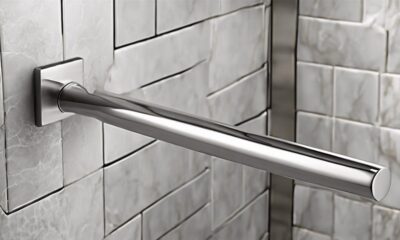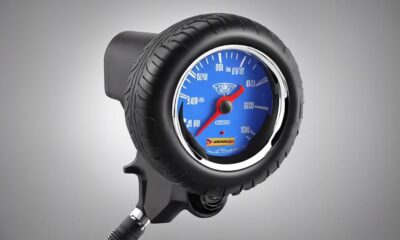Appliances
What Is the Winter Setting on a Ceiling Fan
2025
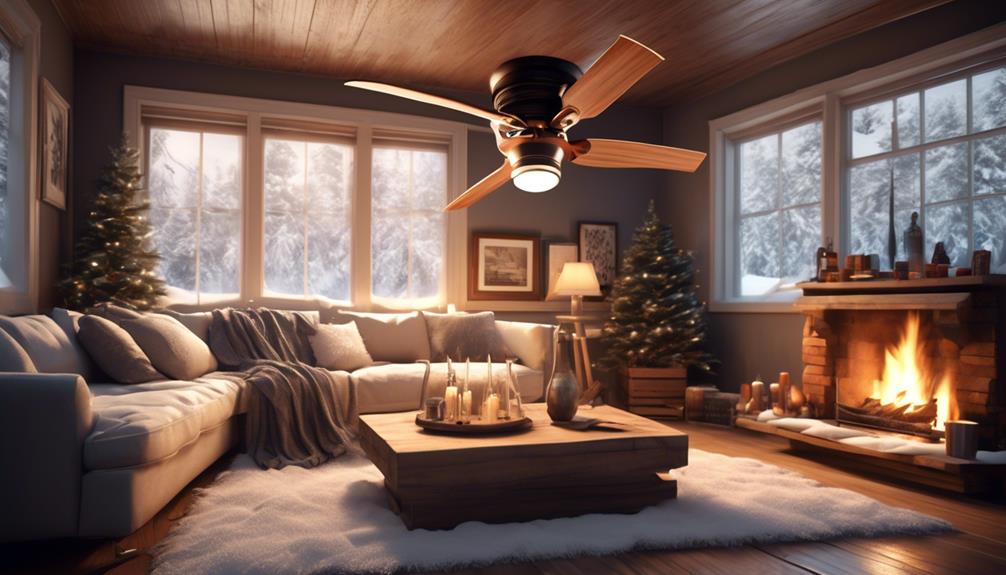
Throughout the winter season, a lot of us tend to adjust our thermostats to keep our living spaces warm and inviting. However, were you aware that your ceiling fan can contribute to preserving a pleasant temperature indoors?
That's where the winter setting on a ceiling fan comes in. This setting, often denoted by a switch on the fan's housing, allows you to change the direction of the fan blades. By utilizing the winter setting, the fan can help circulate warm air, making your space feel more comfortable without relying solely on your heating system.
In this article, we will explore the importance of the winter setting, how it works, its benefits, and some common misconceptions surrounding its use.
Key Takeaways
- The winter setting on a ceiling fan helps maintain comfort and energy efficiency during colder months.
- It redistributes warm air from the ceiling back down into the room, increasing comfort levels and reducing the need for additional heating.
- Using the winter setting saves energy by utilizing the ceiling fan to circulate warm air and prevents heat loss in rooms with high ceilings or poor insulation.
- The winter setting also enhances air quality by distributing fresh air, reducing allergens and pollutants, and creates a cozy and inviting atmosphere in living spaces.
Importance of the Winter Setting
The winter setting on a ceiling fan is an essential feature that plays a significant role in maintaining comfort and energy efficiency during the colder months. By utilizing the winter setting, you can maximize warmth in your living spaces while also saving energy.
During winter, warm air rises and collects near the ceiling, leaving the lower areas of the room feeling chilly. The winter setting on a ceiling fan helps to address this issue by reversing the direction of the fan blades. Instead of pushing air downwards, it gently pulls air upwards, creating an updraft. This updraft redistributes the warm air from the ceiling back down into the room, effectively increasing comfort levels and reducing the need for additional heating.
How the Winter Setting Works
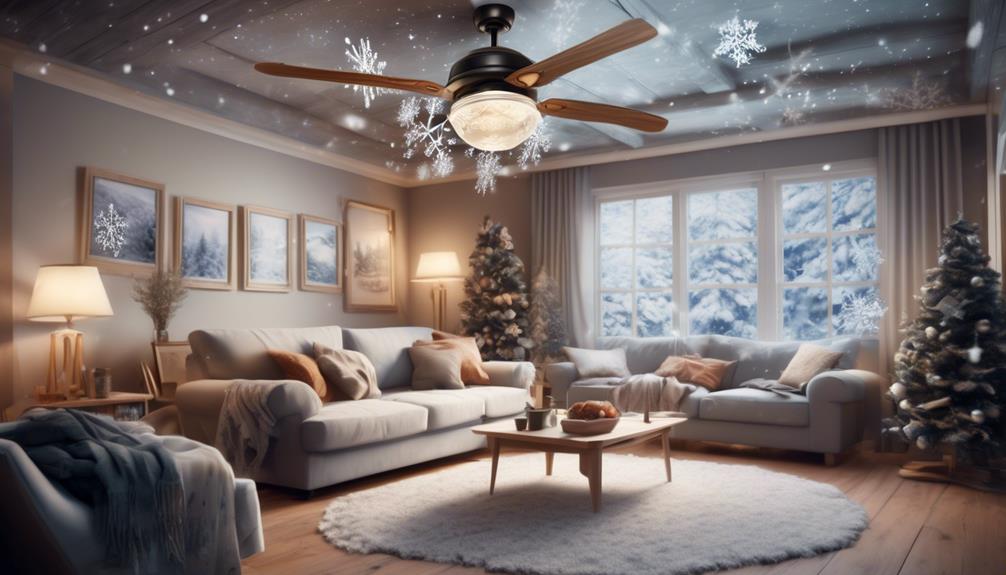
To understand how the winter setting on a ceiling fan works, it is important to grasp the concept of air circulation and the role it plays in maintaining a comfortable environment during colder months. The direction of rotation of a ceiling fan determines whether it is set for summer or winter use. In the summer, the fan should rotate counterclockwise to create a breeze that cools the room. However, in the winter, the fan should be set to rotate clockwise. This clockwise rotation helps to redistribute warm air that tends to rise and accumulate near the ceiling. By gently pushing the warm air back down towards the living space, the fan helps to maintain a more even temperature throughout the room.
Here is a table that illustrates the difference in the direction of rotation and the corresponding effect on heat distribution:
| Season | Direction of Rotation | Effect on Heat Distribution |
|---|---|---|
| Summer | Counterclockwise | Creates a cooling breeze |
| Winter | Clockwise | Redistributes warm air |
Direction of Fan Blades in Winter Mode
In winter mode, the direction of the fan blades is adjusted to maximize the redistribution of warm air throughout the room. By reversing the direction of the fan blades, the ceiling fan helps to prevent drafts and improve air circulation. In this mode, the fan blades rotate clockwise, as opposed to the usual counterclockwise rotation during the summer mode.
The clockwise rotation of the fan blades during winter mode creates an updraft that pushes the warm air near the ceiling down towards the floor. This helps to eliminate cold spots and prevents the warm air from accumulating near the ceiling, where it's of little use. By circulating the warm air downwards, the ceiling fan helps to evenly distribute the heat throughout the room, making it more comfortable and reducing the need for additional heating sources.
Furthermore, by improving air circulation, the ceiling fan in winter mode can also help to reduce energy consumption. When warm air is distributed more efficiently, the thermostat can be set at a lower temperature without sacrificing comfort. This can result in energy savings and lower heating costs.
Benefits of Using the Winter Setting

Using the winter setting on your ceiling fan offers several benefits.
First, it increases energy efficiency by circulating warm air throughout the room, allowing you to lower your thermostat and save on heating costs.
Second, it promotes better air circulation, preventing stagnant air and reducing the likelihood of mold and mildew growth.
Energy Efficiency
Using the winter setting on your ceiling fan can greatly improve energy efficiency.
The winter setting, also known as the reverse or clockwise setting, is designed to help with temperature regulation and cost savings during the colder months.
When the fan is set to the winter mode, it pushes the warm air trapped near the ceiling down towards the floor, creating a more even distribution of heat throughout the room.
This allows you to lower your thermostat and still maintain a comfortable temperature, resulting in cost savings on your energy bills.
The winter setting is especially beneficial in rooms with high ceilings or areas with poor insulation, as it helps to prevent heat loss and reduce the need for additional heating.
Air Circulation
By utilizing the winter setting on your ceiling fan, you can enhance air circulation and achieve optimal temperature regulation in your home during the colder months. This setting is designed to operate the fan in a clockwise direction, which helps to circulate the warm air that naturally rises to the ceiling.
Here are the benefits of using the winter setting:
- Improved Comfort: The circulating warm air prevents cold spots in your living space, ensuring a more comfortable environment.
- Energy Efficiency: By using the winter setting, you can reduce your reliance on heating systems, allowing you to save on energy costs.
- Enhanced Air Quality: Proper circulation helps in distributing fresh air and reducing the buildup of allergens, dust, and other pollutants.
Comfort and Warmth
To maximize comfort and warmth during the colder months, the winter setting on your ceiling fan is an effective solution. By utilizing this setting, you can regulate the temperature in your space while optimizing warmth.
The winter setting on a ceiling fan works by reversing the direction of the fan blades, causing the warm air that rises to be circulated back down to the living space. This prevents the warm air from accumulating near the ceiling and promotes even distribution throughout the room.
Energy-Saving Features of the Winter Setting
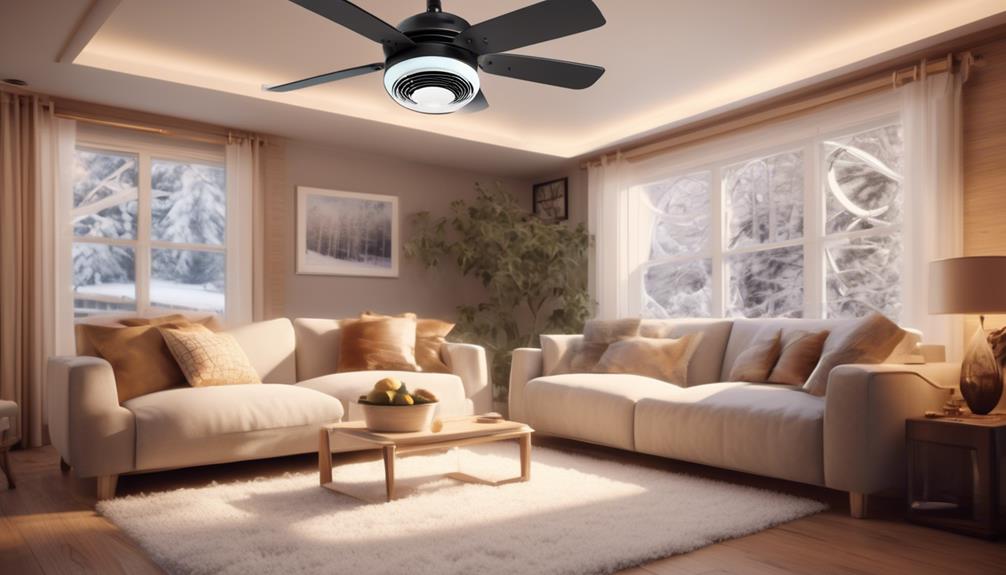
The winter setting of a ceiling fan incorporates energy-saving features that maximize efficiency during colder months. By utilizing these features, homeowners can improve air circulation and reduce heating costs.
Here are three important energy-saving features of the winter setting:
- Reverse Rotation: The winter setting allows the fan blades to rotate in the opposite direction compared to the summer setting. This helps to gently push warm air that naturally rises to the ceiling down towards the living space, resulting in improved heat distribution and reduced reliance on heating systems.
- Speed Control: Ceiling fans with a winter setting often come with multiple speed options. By adjusting the fan speed to a lower setting, homeowners can further optimize energy savings. Slower fan speeds ensure a gentle circulation of air without creating a draft, helping to maintain a comfortable and warm environment.
- Timer Function: Some ceiling fans with a winter setting offer a timer function, allowing users to set a specific duration for the fan to operate. This feature is particularly useful for those who prefer to have the fan run only for a certain period. By using the timer function wisely, homeowners can save energy by avoiding unnecessary fan operation.
Creating a Draft-Free Environment

After discussing the energy-saving features of the winter setting, we can now explore how to create a draft-free environment with a ceiling fan. Drafts can make a room feel colder, leading to discomfort and higher heating costs. By improving insulation and reducing drafts, we can achieve a more comfortable and energy-efficient space.
Firstly, it's important to assess the insulation in your home. Insufficient insulation can result in heat loss and drafts. Consider adding insulation to your walls, floors, and attic to minimize air leakage. This won't only help create a draft-free environment but also reduce your heating costs.
Next, seal any gaps or cracks around windows, doors, and electrical outlets. These small openings can allow cold air to enter and warm air to escape, creating drafts. Use weatherstripping or caulking to seal these gaps and prevent unwanted airflow.
In addition, using a ceiling fan in conjunction with a well-insulated room can further enhance draft reduction. Set your ceiling fan to rotate clockwise on the lowest speed. This will gently circulate the warm air trapped near the ceiling back down into the room. By redistributing the warm air, you can maintain a more consistent temperature and reduce the need for additional heating.
Improving Air Circulation in Winter

Let's now focus on improving air circulation in winter by considering three key points:
- Fan blade direction: Adjusting the fan blade direction to rotate clockwise helps to push warm air towards the ceiling and down the walls, creating a more even distribution of heat.
- Reverse switch function: Utilizing the reverse switch function allows the fan to operate in a clockwise direction, maximizing the circulation of warm air.
- Warm air distribution: By strategically placing fans around the room, we can enhance the movement of warm air and ensure a comfortable and efficient heating system.
Fan Blade Direction
To improve air circulation in winter, there are three key points to consider.
- Reverse the fan blade angle: By reversing the direction of your ceiling fan blades, you can push warm air down from the ceiling and create a more even distribution of heat throughout the room.
- Enhance air circulation patterns: Changing the fan blade direction helps to break up stagnant air pockets and prevent the buildup of condensation on windows and walls.
- Maximize energy efficiency: By utilizing your ceiling fan effectively, you can reduce your reliance on heating systems and save on energy costs.
Reverse Switch Function
When adjusting the reverse switch function on your ceiling fan, you can effectively improve air circulation in winter, allowing for a more comfortable and evenly heated environment.
The reverse switch benefits are often misunderstood, leading to common winter setting myths. By activating the reverse switch, the ceiling fan blades rotate in the opposite direction, creating an updraft that pushes warm air trapped near the ceiling down towards the floor. This helps to eliminate cold spots and prevents heat from being wasted.
Contrary to popular belief, the reverse switch doesn't cool the room but works in conjunction with your heating system to distribute warm air more efficiently.
It's important to note that the reverse switch function should only be used when the heating system is active.
Warm Air Distribution
Improving air circulation in winter can be achieved by activating the reverse switch on your ceiling fan. This feature enables the fan blades to rotate clockwise, creating a gentle updraft that redistributes warm air throughout the room. By utilizing warm air circulation, you can enhance temperature control and create a more comfortable environment during the colder months.
To optimize warm air distribution, consider the following tips:
- Set your ceiling fan to a low speed to avoid creating a draft.
- Ensure that the fan is running in the reverse direction, indicated by the switch being flipped in the opposite position.
- Keep the fan on consistently to maintain a consistent flow of warm air.
Enhancing Heat Distribution in the Room

One effective way to enhance heat distribution in the room is by adjusting the ceiling fan's rotation direction. By changing the rotation direction to run in a clockwise direction during winter, the ceiling fan can help maximize warmth and reduce heating costs.
When the fan rotates clockwise, it creates an updraft that pushes the warm air near the ceiling down towards the floor. This allows the warm air to circulate throughout the room, preventing it from accumulating near the ceiling and leaving the lower parts of the room cooler.
The clockwise rotation of the ceiling fan during winter also helps to break up any stagnant air pockets that may form in the room. This promotes better air circulation and ensures that the warm air is evenly distributed, reducing the need for additional heating sources.
This adjustment can be made by simply flipping the switch on the fan's motor housing to change the rotation direction.
Ideal Temperature Settings for Winter Mode

When it comes to the ideal temperature settings for winter mode on your ceiling fan, there are a few key points to consider.
First, energy-efficient heating options can help you save on your utility bills while keeping your home cozy.
Second, utilizing the winter mode on your ceiling fan can help distribute heat evenly throughout the room, maximizing its effectiveness.
Lastly, we'll provide temperature control tips to help you find the perfect balance between comfort and energy savings.
Energy-Efficient Heating Options
To achieve optimal energy efficiency during the winter months, it's advisable to set your thermostat to a lower temperature when using energy-efficient heating options. This not only helps reduce energy consumption but also saves you money on your heating bills.
Here are three energy-efficient heating solutions to consider:
- Programmable thermostats: These allow you to set different temperatures for different times of the day, ensuring that you only heat your home when needed.
- Insulation: Proper insulation helps retain heat inside your home, reducing the need for constant heating.
- Zone heating: Instead of heating your entire home, zone heating allows you to heat specific areas or rooms, saving energy and resources.
Benefits of Winter Mode
Using the winter mode setting on your ceiling fan can provide numerous benefits during the colder months.
One of the key advantages is improving insulation in your home. When the fan is set to winter mode, it rotates in a clockwise direction at a low speed. This gentle circulation of air helps to push warm air that naturally rises to the ceiling back down towards the living space.
As a result, the temperature in the room becomes more even and comfortable. By redistributing warm air, the winter mode setting can also help to reduce heating costs.
With improved air circulation, your heating system doesn't have to work as hard to maintain a consistent temperature, leading to potential energy savings.
Temperature Control Tips
To optimize the benefits of the winter mode setting on your ceiling fan, it's important to choose the ideal temperature settings for maximum comfort and energy efficiency. When setting the ideal temperature, keep in mind that every degree matters.
Here are some temperature control tips to help you reduce heating costs while staying cozy:
- Set the thermostat to a lower temperature when you're asleep or away from home. A reduction of just a few degrees can result in significant energy savings.
- Use a programmable thermostat to automatically adjust the temperature based on your schedule. This ensures that your home is warm when you need it and saves energy when you don't.
- Consider layering clothing and using blankets to stay warm instead of cranking up the heat. This allows you to maintain a lower temperature setting while still feeling comfortable.
Adjusting Fan Speed for Optimal Comfort
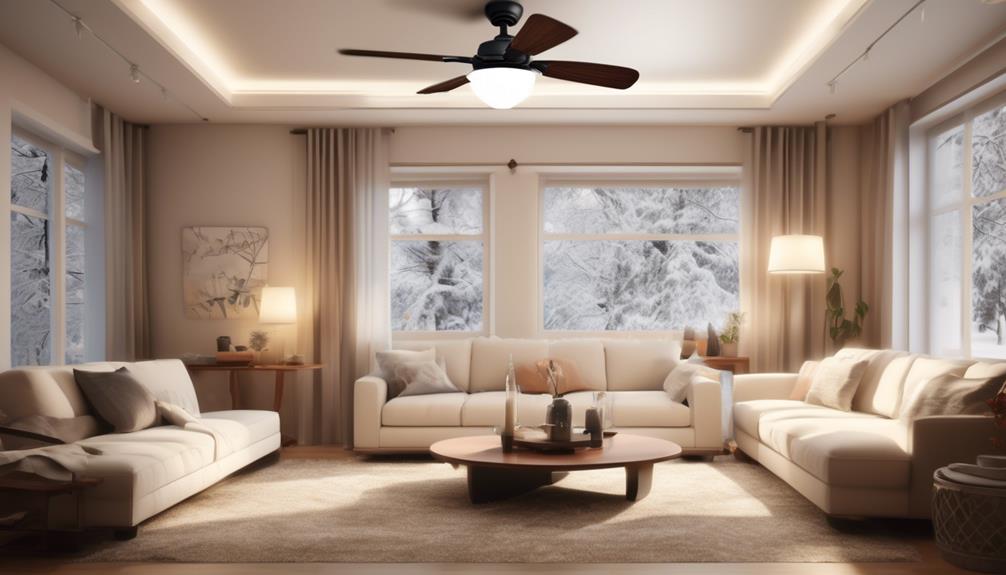
Adjust the speed of your ceiling fan for optimal comfort by utilizing the various settings available. By adjusting the fan speed, you can create a pleasant airflow that helps to regulate the temperature in your room. This is especially useful during the winter months when you want to distribute warm air evenly throughout the space.
To help you understand the different fan speed settings, refer to the table below:
| Speed Setting | Description | Best Use |
|---|---|---|
| Low | Gentle breeze | Ideal for maintaining a comfortable temperature in a small room. |
| Medium | Moderate airflow | Suitable for larger rooms or areas where you need a balanced cooling effect. |
| High | Strong airflow | Effective for quickly cooling down a room or providing ventilation in a stuffy space. |
When adjusting the fan speed, consider factors such as room size, temperature preferences, and personal comfort. Keep in mind that using a ceiling fan does not replace the need for adjusting the thermostat or using space heaters. Rather, it complements these temperature control methods by improving air circulation and creating a more comfortable indoor environment.
Using the Winter Setting in Different Rooms
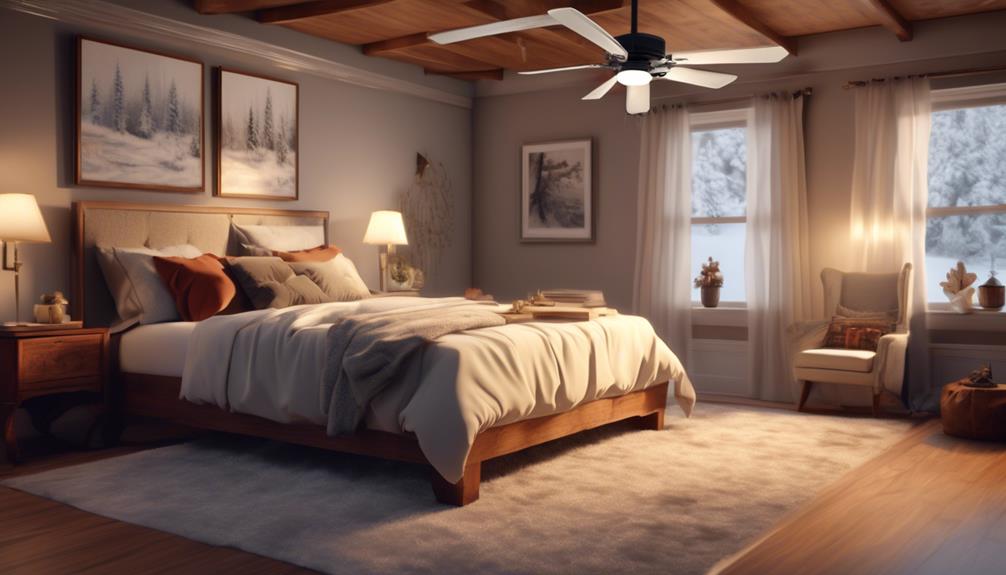
As we explore the winter setting in different rooms, it's important to consider how adjusting the ceiling fan speed can optimize airflow and maintain a comfortable temperature throughout your home. The winter setting on a ceiling fan is designed to help distribute warm air, allowing you to lower your thermostat and save on heating costs.
Here are some key considerations when using the winter setting for temperature control and optimizing fan speed in different rooms:
- Room Size: Adjusting the fan speed based on the size of the room is crucial. In larger rooms, setting the fan speed to a higher setting will help circulate warm air more effectively. For smaller rooms, a lower fan speed will suffice.
- Ceiling Height: The height of the ceiling also plays a role in optimizing fan speed. For rooms with higher ceilings, increasing the fan speed will help ensure the warm air is evenly distributed throughout the space.
- Direction of Rotation: The winter setting typically involves running the fan in a clockwise direction. This helps push warm air trapped near the ceiling down to the floor, creating a more comfortable environment.
Maintenance Tips for the Winter Setting
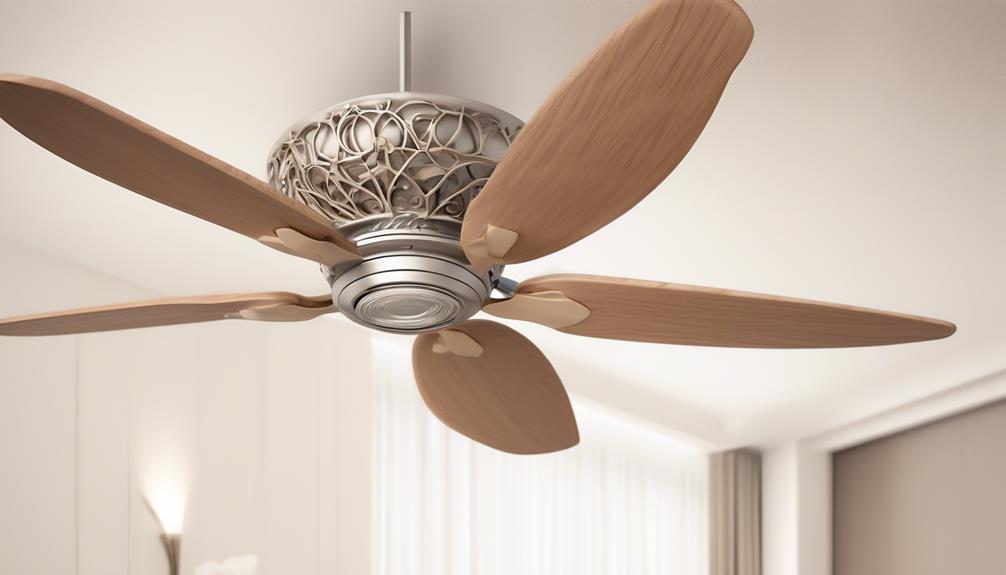
Now let's talk about some important maintenance tips for the winter setting of your ceiling fan.
By properly maintaining your fan, you can ensure optimal performance and energy-saving benefits throughout the colder months.
One key aspect is to make sure the fan is set to rotate clockwise, as this will help circulate warm air trapped near the ceiling back down into the room.
Energy-Saving Benefits
To maximize energy efficiency during the winter months, it's advisable to properly maintain the ceiling fan. By doing so, you can enjoy several energy-saving benefits and effectively control the temperature in your home. Here are some maintenance tips for the winter setting:
- Clean the fan blades regularly to ensure optimal airflow and efficiency.
- Reverse the direction of the fan blades to clockwise. This will create an updraft, pushing warm air down and redistributing it throughout the room.
- Adjust the fan speed to a low setting. This will help circulate the warm air without causing a cooling effect.
Proper Fan Direction
Proper maintenance of the ceiling fan during the winter setting includes ensuring the fan blades are cleaned regularly for optimal airflow and efficiency. In addition to cleaning, it is crucial to set the fan direction correctly to maximize its performance during the colder months. By adjusting the fan direction, you can enhance temperature control and achieve energy savings. To help you understand the proper fan direction for winter, refer to the table below:
| Fan Speed | Proper Direction | Benefits |
|---|---|---|
| Low | Clockwise | Gentle circulation of warm air throughout the room |
| Medium | Clockwise | Efficiently distributes warm air without creating drafts |
| High | Clockwise | Powerful dispersal of warm air, ideal for larger spaces |
Common Misconceptions About the Winter Setting

There are several common misconceptions surrounding the winter setting of a ceiling fan. Let's debunk these common myths and shed light on the truth about the winter setting:
- Myth 1: The winter setting generates heat. Contrary to popular belief, the winter setting on a ceiling fan doesn't produce heat. It simply redistributes the warm air that rises to the ceiling, allowing it to circulate back down into the room, creating a more even temperature.
- Myth 2: The winter setting is only for cold climates. The winter setting of a ceiling fan can be beneficial in any climate, whether it's cold or mild. By using the winter setting, you can maximize energy efficiency and reduce heating costs by making your heating system work more efficiently.
- Myth 3: The winter setting should always be on high speed. While it's true that using a higher fan speed in winter can help with air circulation, it's not always necessary. In fact, using a lower speed setting can be more than sufficient to achieve the desired effect without creating a draft or causing discomfort.
Other Uses for the Winter Setting

Now that we've debunked the common myths surrounding the winter setting of a ceiling fan, let's explore the various other uses for this setting.
In addition to cooling during the summer months, the winter setting on a ceiling fan can be utilized to maximize warmth and enhance energy efficiency in your home.
One of the main benefits of using the winter setting is its ability to circulate warm air throughout a room. By setting your fan to run in a clockwise direction at a low speed, you can help distribute the warm air that naturally rises to the ceiling. This can be particularly useful in rooms with high ceilings or areas where heat tends to gather, such as near a fireplace or radiator.
Using the winter setting on your ceiling fan can also help you save on energy costs. By circulating the warm air, you can maintain a more consistent temperature throughout the room, allowing you to lower your thermostat and still feel comfortable. This can lead to significant energy savings over time.
To maximize the benefits of the winter setting, it's important to ensure that your ceiling fan is clean and in good working condition. Regular maintenance, such as dusting the blades and ensuring proper balance, can help optimize its performance and efficiency.
Frequently Asked Questions
Can I Use the Winter Setting on My Ceiling Fan During the Summer Months?
Yes, you can use the winter setting on your ceiling fan during the summer months. The winter setting on a ceiling fan is designed to redistribute warm air that rises to the ceiling back down into the room.
However, it's important to note that using the winter setting during summer won't provide the same level of cooling as the regular fan setting.
Regular ceiling fan maintenance and energy efficiency practices should still be followed to ensure optimal performance and energy savings.
Will Using the Winter Setting on My Ceiling Fan Help Reduce My Heating Bills?
Using the winter setting on a ceiling fan can be an effective way to reduce heating costs.
By reversing the direction of the fan blades, the warm air that rises to the ceiling is pushed back down into the room.
This helps to distribute the heat more evenly and prevents it from escaping through the ceiling.
The winter setting on a ceiling fan can be a cost-saving option during the colder months, maximizing the efficiency of your heating system.
How Does the Winter Setting on a Ceiling Fan Affect the Airflow in the Room?
When it comes to the winter setting on a ceiling fan, we've got the scoop on how it affects the airflow in the room.
This setting is designed to improve air circulation, helping to distribute warm air throughout the space. By running the fan in reverse, it pushes the air upwards, which then circulates back down along the walls.
This clever trick can enhance energy efficiency by reducing the need for excessive heating, ultimately saving you some hard-earned cash on those heating bills.
Can Using the Winter Setting on My Ceiling Fan Help Prevent Condensation on Windows?
Using the winter setting on a ceiling fan can indeed help prevent condensation on windows. This is because the winter setting, which rotates the fan blades clockwise, creates an updraft that pushes warm air downwards and circulates it throughout the room.
Are There Any Safety Concerns or Precautions to Keep in Mind When Using the Winter Setting on a Ceiling Fan?
When using the winter setting on a ceiling fan, there are a few safety concerns and precautions to keep in mind.
First, make sure the fan is securely mounted to prevent it from falling.
Second, keep the fan blades clean and free of dust to avoid any potential fire hazards.
Lastly, ensure that the fan is operating smoothly and there are no loose parts that could cause injury.
It's also important to note that using the winter setting can improve energy efficiency by distributing warm air throughout the room.
How Does the Winter Setting on a Ceiling Fan Impact Speed Control and Installation?
The winter setting on a ceiling fan impacts the speed control and installation. Ceiling fan speed control installation in the winter helps to circulate warm air throughout the room. Installation of the fan in the correct direction and adjusting the speed control can help improve energy efficiency and overall comfort during colder months.
Do Ceiling Fans Have Different Settings for Different Seasons?
Yes, ceiling fans do have different settings for different seasons. In the summer, setting the fan to rotate counterclockwise on the highest speed helps create a cool breeze. In the winter, setting the fan to rotate clockwise on a low speed helps distribute warm air from the ceiling fan ac meaning efficiently.
Conclusion
In conclusion, the winter setting on a ceiling fan is a valuable feature that can help save energy and keep your home comfortable during the colder months.
By reversing the direction of the fan blades, the winter setting pushes warm air down from the ceiling, creating a cozy environment.
Just like a warm blanket on a chilly night, the winter setting provides a metaphorical embrace for your home, ensuring a snug and inviting atmosphere throughout the winter season.
- About the Author
- Latest Posts
Introducing Ron, the home decor aficionado at ByRetreat, whose passion for creating beautiful and inviting spaces is at the heart of his work. With his deep knowledge of home decor and his innate sense of style, Ron brings a wealth of expertise and a keen eye for detail to the ByRetreat team.
Ron’s love for home decor goes beyond aesthetics; he understands that our surroundings play a significant role in our overall well-being and productivity. With this in mind, Ron is dedicated to transforming remote workspaces into havens of comfort, functionality, and beauty.
Garage Door Opener
Wiring Your Liftmaster Garage Door Opener: 3 Easy Steps
Uncover the secrets to effortlessly wiring your Liftmaster garage door opener with finesse, ensuring a secure and functional setup that you won't want to miss.

Let’s discuss the important process of making sure your Liftmaster garage door opener is correctly connected with precision. By following these simple steps, you can effectively handle the wiring of your system.
Curious about how to seamlessly integrate your garage door opener into your home? Stay tuned as we navigate through the crucial steps together, demystifying the process for a secure and functional setup that you won't want to miss.
Key Takeaways
- Properly wire power supply to opener terminals for electrical connection.
- Connect control panel to opener with correct wire placement for functionality.
- Install safety sensors across from each other and connect to opener securely.
- Maintain remote control functionality and opener longevity through regular checks and lubrication.
Wiring the Power Source
To wire the power source for your Liftmaster garage door opener, connect the designated power source wires to the specified terminals on the opener, ensuring proper polarity by matching positive and negative terminals securely using a screwdriver.
Begin by identifying the power supply wires coming from the electrical outlet. Strip the insulation at the ends of the wires to expose the conductive material.
Next, locate the screw terminals on the garage door opener, usually found near the mounting bracket. Insert the positive wire into the corresponding positive terminal, ensuring a snug fit. Repeat the process for the negative wire, inserting it into the negative terminal.
Use the screwdriver to tighten the screws, securing the wires in place. Double-check the connections to guarantee no loose wires that could lead to malfunctions. Confirm the voltage requirements of the garage door opener match those of the power supply to prevent damage.
This meticulous approach ensures a safe and efficient power supply for your garage door opener.
Connecting the Control Panel

Mount the control panel of your Liftmaster garage door opener within sight of the door for convenient access and operational efficiency. When connecting the control panel, ensure proper polarity of the wires to guarantee functionality.
Here are essential steps to follow:
- Secure Mounting: Attach the control panel securely to the wall to prevent any unwanted movement during operation.
- Wiring: Run the wires from the control panel to the garage door opener and connect them to the designated terminals following the manufacturer's instructions.
- Warning Placard: Affix the warning placard near the control panel as a safety reminder for users interacting with the garage door opener.
Proper installation of the control panel is crucial for the overall performance of your Liftmaster garage door opener. By following these steps diligently, you can ensure a smooth and efficient operation of your garage door system.
Securing Safety Sensors
When securing safety sensors for your Liftmaster garage door opener, ensure precise alignment and proper wiring to guarantee optimal functionality and safety. The sensors, crucial for detecting obstacles in the path of the garage door, work by transmitting an invisible light beam.
Start by mounting the sensors across from each other on the wall, using the provided mounting brackets. It's essential to align the sensors correctly to ensure the invisible light beam path is unobstructed. Use staples to secure the sensor wiring along the wall, keeping it neat and out of the way.
When wiring, connect the sensor wires to the appropriate terminals on the Liftmaster garage door opener, following the manufacturer's safety guidelines. Remember always to disconnect the power to the opener before installation to prevent any accidents.
Frequently Asked Questions
How Do I Connect My Liftmaster Garage Door Opener?
To connect your Liftmaster garage door opener, follow these steps:
- Locate and identify the terminals on the opener connected to the wall button, typically labeled 1 and 2.
- Using a screwdriver, release the push-type terminals and securely insert the stripped ends of hookup wires.
- Connect the wires from the wall button to the designated terminals on the garage door motor unit.
- Ensure proper wire management by securing and hiding the wires to avoid interference with the door's operation.
How Many Wires Do You Need for a Garage Door Opener?
When setting up a garage door opener, we typically require a minimum of 2 wires for standard functionality. However, some advanced models might necessitate extra wires for specific features.
These wires establish the connection between the control panel/remote and the opener motor, enabling signal transmission for door operation.
Ensuring proper wiring is crucial for optimal performance of your Liftmaster garage door opener.
How Do You Wire a Push Button Garage Door Opener?
When wiring a push button garage door opener, we start by identifying the terminals on the opener that connect to the push button.
Using a screwdriver, we release and insert the stripped ends of hookup wires into the designated terminals on the motor unit.
We then ensure a secure connection by twisting and fastening the wires.
Proper wire routing is crucial to prevent interference with the garage door's operation.
How to Program the Garage Door Opener in Your Car in 3 Easy Steps?
When programming your garage door opener in your car, locate the 'Learn' button on the opener motor unit. Press and release it, then swiftly return to your car to hold the desired button for programming. Wait for the light to flash or hear two clicks to confirm.
Test the button to ensure successful programming.
These steps are essential for seamless operation of your Liftmaster system.
Conclusion
In conclusion, wiring your Liftmaster garage door opener is as simple as connecting the dots. Just like a skilled electrician effortlessly navigates a circuit board, you can confidently wire your opener with ease.
By following the three easy steps outlined, you'll have your garage door opener up and running smoothly in no time.
So, grab your tools and get ready to bring power to your garage door with precision and confidence.
- About the Author
- Latest Posts
Introducing Ron, the home decor aficionado at ByRetreat, whose passion for creating beautiful and inviting spaces is at the heart of his work. With his deep knowledge of home decor and his innate sense of style, Ron brings a wealth of expertise and a keen eye for detail to the ByRetreat team.
Ron’s love for home decor goes beyond aesthetics; he understands that our surroundings play a significant role in our overall well-being and productivity. With this in mind, Ron is dedicated to transforming remote workspaces into havens of comfort, functionality, and beauty.
Garage Door Opener
Choosing the Right Size Battery for Your Garage Door Opener
Find out why selecting the perfect battery size for your garage door opener is crucial for avoiding disruptions and ensuring smooth operation.

We’ve all experienced it – 70% of garage door opener malfunctions are caused by battery problems. Choosing the correct size battery is crucial for smooth operation.
But how do you know which battery is the perfect fit for your opener? Let's shed light on this essential aspect to keep your garage running smoothly and avoid unexpected disruptions.
Key Takeaways
- Consider manufacturer's voltage requirements for optimal performance.
- Choose the correct battery size for longer opener lifespan.
- Rechargeable batteries offer cost-effectiveness and consistent power.
- Adhere to manufacturer's recommendations for efficient operation.
Factors to Consider When Choosing Battery Size
When selecting the appropriate battery size for your garage door opener, it's crucial to carefully consider the voltage requirements specified by the manufacturer. Adhering to the manufacturer's recommendations ensures that the battery size is compatible with your garage door opener, providing the necessary power source for optimal performance. Choosing the correct battery size not only allows for efficient operation but also contributes to a longer lifespan for your garage door opener.
Opting for a rechargeable battery can be a practical choice, offering the advantage of being reusable and environmentally friendly. Rechargeable batteries provide a cost-effective solution in the long run, as they can be recharged multiple times before needing replacement. Additionally, they often have a higher capacity compared to disposable batteries, ensuring a consistent power supply to your garage door opener.
Types of Batteries for Garage Openers

For selecting the appropriate battery type for garage door openers, consideration of lithium, alkaline, and rechargeable options is essential based on their power characteristics and longevity.
When it comes to garage door opener batteries, here are the options to consider:
- Lithium Batteries: Known for their long-lasting power and reliability, lithium batteries are commonly used in garage door opener remote controls.
- Alkaline Batteries: Offering a non-rechargeable but reliable power source, alkaline batteries are another viable option for garage door openers.
- Rechargeable Batteries: Rechargeable options like nickel-cadmium (NiCd) and lithium-ion (Li-ion) provide sustainability and cost-effectiveness for long-term use in garage door openers.
- Manufacturer's Recommendations: Battery size and type depend on the specific brand and model of the garage door opener, so it's crucial to check the manufacturer's recommendations to ensure optimal performance and prevent malfunctions.
Popular Battery Brands for Openers
Among the array of battery brands available for garage door openers, Duracell stands out for its reputation of delivering enduring power and exceptional performance.
Known for their long-lasting power and reliable performance, Energizer batteries are a popular choice for various garage door opener models.
Panasonic batteries are recognized for their durability, reliability, and high energy output, making them a preferred option for many users.
Rayovac offers value for money with its combination of long-lasting performance and reliability, making it a top contender in the market of garage door opener batteries.
Eveready also provides dependable options for garage door opener batteries, ensuring consistent power and performance.
When choosing the right battery for your garage door opener, considering these popular brands can help you find the optimal balance between longevity, reliability, and performance for your specific needs.
How to Replace Garage Door Opener Battery

Having identified the specific battery type required for your garage door opener, the next step is to open the remote control cover correctly to access the battery compartment for replacement.
When replacing the battery for your garage door opener, follow these steps:
- Open the Cover: Gently slide the cover of the remote control in the direction indicated to reveal the battery compartment.
- Remove the Old Battery: Carefully take out the old battery by pushing it gently from the sides to release it from the connectors.
- Insert the New Battery: Place the new battery in the compartment, ensuring the correct orientation as per the markings inside.
- Close the Cover: Once the new battery is securely in place, slide the cover back onto the remote control until it clicks shut.
Troubleshooting Tips for Battery Issues
To troubleshoot battery issues with your garage door opener, we recommend conducting a thorough inspection of the battery compartment and connections. Start by checking the brand and model of your garage door opener remote to determine the correct battery type needed for replacement. It's crucial to use the specific battery number designated by the manufacturer to prevent compatibility problems with your garage door opener.
If necessary, refer to the owner's manual or open the transmitter to identify the exact battery required for your remote control. Pay attention to any colored smart buttons on the remote, such as yellow ones for Security+ 2.0 models, which may indicate the particular battery type needed. Always ensure the proper functioning of your garage door opener remote by using the right battery number and avoiding substitutions to prevent any potential damage.
Frequently Asked Questions
What Size Battery Does My Garage Door Opener Take?
We must ascertain the specific battery size required by your garage door opener for optimal performance.
It's crucial to identify the manufacturer-specified battery number and the type indicated by the colored smart buttons on the remote control.
Accessing the battery compartment through the proper opening of the remote control cover is essential for replacement.
Ensuring the correct battery size will guarantee seamless operation of your garage door opener.
What Battery Is Best for Garage Door Opener?
We've found that longevity is crucial when selecting the best battery for a garage door opener, with lithium batteries lasting approximately 5 years.
It's vital to match the specific battery type recommended for your transmitter to avoid compatibility issues.
Do Garage Door Openers Need Special Batteries?
Yes, garage door openers do require special batteries. These batteries, like 3-volt lithium or 12-volt options, are crucial for reliable remote operation in various settings. Having the correct battery size is essential to prevent malfunctions and ensure smooth garage door operation.
Additionally, certain keypads and remote controls may need 9-volt batteries for backup power in keyless entry systems. Selecting the right size and type of battery is vital for consistent functionality.
What Battery Do I Need for Liftmaster Garage Door Opener?
We need a CR2016 or CR2032 3-volt lithium battery for our LiftMaster garage door opener.
It's crucial to check the model specifications for the correct battery type. Proper maintenance and timely battery replacement are essential for smooth operation.
Make sure to have the right battery on hand to avoid any disruptions in functionality.
Conclusion
In conclusion, selecting the appropriate battery size for your garage door opener is imperative for optimal performance. By considering factors such as capacity, lifespan, and voltage requirements, you can ensure smooth operation.
Choosing reputable brands like Duracell or Energizer and performing regular maintenance will further enhance reliability. Remember, a well-chosen battery can make all the difference between seamless functionality and unexpected disruptions.
Choose wisely for peace of mind.
- About the Author
- Latest Posts
Introducing Ron, the home decor aficionado at ByRetreat, whose passion for creating beautiful and inviting spaces is at the heart of his work. With his deep knowledge of home decor and his innate sense of style, Ron brings a wealth of expertise and a keen eye for detail to the ByRetreat team.
Ron’s love for home decor goes beyond aesthetics; he understands that our surroundings play a significant role in our overall well-being and productivity. With this in mind, Ron is dedicated to transforming remote workspaces into havens of comfort, functionality, and beauty.
Garage Door Opener
Cost-Effective LiftMaster Garage Door Opener Options
Get ready to explore cost-effective LiftMaster garage door opener options that offer a perfect blend of affordability and functionality, unlocking hidden treasures for your garage needs.

When considering cost-effective LiftMaster garage door openers, it can feel like navigating a maze full of hidden treasures just waiting to be discovered.
From the sturdy chain drive models to the sleek belt-operated ones and the space-saving wall-mounted units, each offers a unique blend of affordability and functionality.
But how do you determine which one strikes the perfect balance between cost and features?
Let's explore the key factors that could influence your decision and help you find the ideal LiftMaster opener for your garage needs.
Key Takeaways
- LiftMaster offers cost-effective chain drive openers with myQ technology and battery back-up.
- Affordable belt drive models provide smooth, quiet operation with steel-reinforced rubber belts.
- Wall-mount openers offer space-saving solutions with WiFi connectivity and automatic door lock.
- LiftMaster openers feature built-in WiFi, various drive systems, warranties, and compatibility with accessories.
LiftMaster Chain Drive Opener Prices
Have you considered the cost-effective LiftMaster chain drive opener prices ranging from $200 to $400 for your garage door needs? When it comes to finding a reliable and smart solution for your garage, the LiftMaster Chain Drive Garage Door Opener offers a range of features at accessible prices. Equipped with myQ technology, these openers allow you to control your garage door from anywhere using your smartphone. The convenience doesn't stop there – within this price range, you can choose from various motor options to suit your specific requirements.
In addition to the advanced technology, LiftMaster chain drive openers come with valuable features such as battery back-up systems, built-in lighting for added security, and warranties for peace of mind. Whether you're looking for a basic model or one with all the bells and whistles, LiftMaster offers a range of options that cater to different budgets and preferences. Upgrade your garage door opener to a smart and efficient solution without breaking the bank.
LiftMaster Belt Drive Opener Costs

Considering the affordability of LiftMaster chain drive opener prices, let's now explore the cost-effective range of LiftMaster belt drive opener options for your garage door needs. LiftMaster belt drive garage door openers typically range from $300 to $600, with popular models falling between $375 and $425, offering a balance of quality and affordability. These openers are renowned for their smooth and quiet operation, making them perfect for homes where noise reduction is essential. The steel-reinforced rubber belt ensures durability, and extension kits are available for 8 or 10-foot doors. Customers can rely on the reliable performance of LiftMaster belt drive garage door openers, all at a reasonable price point.
| Features | Description |
|---|---|
| Smooth and Quiet Operation | Ideal for noise reduction in residential settings |
| Steel Reinforced Rubber Belt | Ensures durability and longevity |
| Reliable Performance | Consistent operation you can count on |
LiftMaster Wall-Mount Opener Options
Exploring LiftMaster wall-mount opener options reveals premium solutions ideal for high or irregular ceilings, offering advanced features for enhanced control and security. When considering LiftMaster wall-mount openers, there are several key features to keep in mind:
- Direct Drive Operation: These openers operate without belts or chains, ensuring a smooth and quiet performance.
- WiFi Connectivity and Smart Technology: Enjoy advanced control and monitoring capabilities with options for connectivity to your smart devices.
- Automatic Door Lock: Enhance security with the automatic door lock feature, providing peace of mind when away from home.
- Space-Saving Installations in Residential Settings: Designed for convenience, these openers are ideal for saving space in residential garages, making them a practical choice for any home.
With prices ranging between $500-$600, LiftMaster wall-mount openers offer a reliable and efficient solution for those looking to optimize their garage door opener in unique ceiling situations while enjoying modern conveniences and enhanced security features.
LiftMaster Opener Features Overview

When moving on to discuss the 'LiftMaster Opener Features Overview,' it becomes evident that LiftMaster garage door openers offer a range of advanced features tailored to enhance convenience and security for users.
LiftMaster garage door openers are equipped with built-in WiFi, allowing for seamless operation through smart technology. With options like belt drive and chain drive systems, users can choose the mechanism that best suits their needs. Additionally, features such as battery back-up ensure that the opener functions even during power outages, providing peace of mind.
LiftMaster Garage Door Openers also come with innovative functions like automatic door lock and lifetime warranties, adding value to the user's investment. These openers can be further enhanced with accessories such as cameras, keypads, and motion alerts, offering added convenience and security.
With prices ranging from $200 to $600, LiftMaster provides cost-effective solutions for various budgets, making them a practical choice for those seeking reliable and feature-rich garage door openers.
Garage Door Opener Buying Tips
To make an informed decision when buying a garage door opener, it's essential to consider factors such as budget, required features, and installation requirements. When shopping for a garage door opener, keep in mind the following tips:
- Types of Garage Door Openers: Explore options like chain drive models for affordability or belt-operated models for a balance of quality and cost.
- Smart Home Integration: Consider smart-enabled devices that can be controlled through the LiftMaster myQ app for added convenience.
- Installation Requirements: Evaluate whether you need a wall-mounted opener for space-saving solutions.
- Material Preferences: Decide between a metal chain or a rubber belt based on noise levels and durability.
Frequently Asked Questions
What Is the Average Price of a Liftmaster Garage Door Opener?
We found that the average price of a LiftMaster garage door opener can range between $200 to $1,000.
Basic chain drive models start around $200, while advanced belt-operated ones go up to $600.
Wall-mounted direct drive openers can cost from $400 to $800, and smart-enabled models with WiFi features may range from $400 to $1,000.
Prices vary based on horsepower, additional features, and user preferences.
What Is the Best Liftmaster Garage Door Opener for 2023?
We believe the best LiftMaster garage door opener for 2023 is the LiftMaster Wall Mount Garage Door Opener. Priced between $500-$600+, this model offers premium features like automatic door lock, WiFi, and Smart technology.
It's a top pick for homeowners seeking advanced functionalities. With its innovative design and reliable performance, the LiftMaster Wall Mount Garage Door Opener stands out as a cutting-edge choice for modern garage automation needs.
Which Is a Better Garage Door Opener Genie or Liftmaster?
When comparing Genie and LiftMaster garage door openers, we prefer LiftMaster for its durability, reliability, and advanced security features.
While Genie may seem more budget-friendly initially, LiftMaster's long-term performance and compatibility with smart home systems make it the superior choice.
For enhanced safety and convenience, LiftMaster stands out with its solid warranties and smart technology integration.
What Is the Average Life of a Liftmaster Garage Door Opener?
We've got the scoop on the average lifespan of a LiftMaster garage door opener! These durable and reliable openers typically last around 10-15 years with regular maintenance.
Proper installation and periodic servicing can even extend their longevity. Factors like usage frequency, environmental conditions, and maintenance practices play a role in how long they'll last.
Investing in a quality LiftMaster opener can be a smart choice due to its extended lifespan.
Conclusion
In conclusion, when it comes to cost-effective garage door opener options, LiftMaster offers a range of models to suit different needs and budgets.
Whether you're looking for a chain drive, belt drive, or wall-mount opener, LiftMaster has you covered with features like WiFi connectivity, Smart technology, and battery backups.
Investing in a LiftMaster opener is like having a reliable guardian for your garage, providing security and peace of mind like a trusty shield.
- About the Author
- Latest Posts
Introducing Ron, the home decor aficionado at ByRetreat, whose passion for creating beautiful and inviting spaces is at the heart of his work. With his deep knowledge of home decor and his innate sense of style, Ron brings a wealth of expertise and a keen eye for detail to the ByRetreat team.
Ron’s love for home decor goes beyond aesthetics; he understands that our surroundings play a significant role in our overall well-being and productivity. With this in mind, Ron is dedicated to transforming remote workspaces into havens of comfort, functionality, and beauty.
-

 Decor1 week ago
Decor1 week agoMaximalist Decor Explained: Embrace More Style
-

 Vetted4 weeks ago
Vetted4 weeks ago15 Best Drip Irrigation Systems to Keep Your Garden Thriving
-

 Vetted2 weeks ago
Vetted2 weeks ago15 Best Foot Massagers for Neuropathy to Soothe Your Feet and Relieve Discomfort
-

 Vetted3 weeks ago
Vetted3 weeks ago15 Best Sports Laundry Detergents for Keeping Your Activewear Fresh and Clean
-

 Vetted3 weeks ago
Vetted3 weeks ago15 Best Tall Toilets for Seniors That Combine Comfort and Safety
-

 Vetted4 weeks ago
Vetted4 weeks ago15 Best Dish Scrubbers to Keep Your Kitchen Sparkling Clean
-

 Decor4 weeks ago
Decor4 weeks agoWhat Is Eclectic Home Decor
-

 Vetted5 days ago
Vetted5 days ago15 Best Organic Pest Control Solutions for a Naturally Pest-Free Home








